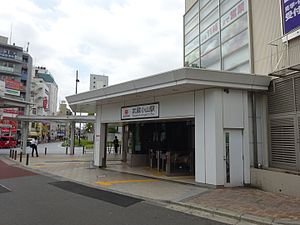Musashi-Koyama Station
MG03 Musashi-Koyama Station 武蔵小山駅 | |
|---|---|
 The east entrance in August 2016 | |
| Location | 3-4-8 Koyama, Shinagawa, Tokyo Japan |
| Operated by | |
| Line(s) | |
| Distance | 2.6 km from Meguro |
| Platforms | 2 island platforms |
| Tracks | 4 |
| Other information | |
| Station code | MG03 |
| Website | Official website |
| History | |
| Opened | 11 March 1923 |
| Rebuilt | July 2006 |
| Previous names | Koyama (until June 1924) |
| Passengers | |
| FY2018 | 53,952 daily[1] |
| Location | |
 MG03 Musashi-Koyama Station Location within Japan | |
Musashi-Koyama Station (武蔵小山駅, Musashi-Koyama-eki) is a railway station on the Tokyu Meguro Line in Shinagawa, Tokyo, Japan, operated by the private railway operator Tokyu Corporation.
Lines[]
Musashi-Koyama Station is served by the Tokyu Meguro Line, and lies 2.6 km from the starting point of the line at Meguro.[2]
Station layout[]
This station has two island platforms serving four tracks. Local trains typically use tracks 1 and 4, while express trains use tracks 2 and 3.
Platforms[]
| 1 | ■ Tokyu Meguro Line | for Ookayama, Den-en-chōfu, Musashi-Kosugi, and Hiyoshi |
| 2 | ■ Tokyu Meguro Line | for Ookayama, Den-en-chōfu, Musashi-Kosugi, and Hiyoshi |
| 3 | ■ Tokyu Meguro Line | for Meguro Tokyo Metro Namboku Line for Akabane-Iwabuchi Saitama Rapid Railway Line for Urawa-Misono Toei Mita Line for Nishi-Takashimadaira |
| 4 | ■ Tokyu Meguro Line | for Meguro Tokyo Metro Namboku Line for Akabane-Iwabuchi Saitama Rapid Railway Line for Urawa-Misono Toei Mita Line for Nishi-Takashimadaira |
Adjacent stations[]
| « | Service | » | ||
|---|---|---|---|---|
| Tokyu Meguro Line | ||||
| Ookayama (MG06) | Express | Meguro (MG01) | ||
| Nishi-Koyama (MG04) | Local | Fudōmae (MG02) | ||
History[]
The station opened on 11 March 1923, initially named simply Koyama Station (小山駅).[2] It was renamed Musashi-Koyama in June 1924.[2]
The station was rebuilt as an underground station, reopening on 2 July 2006.[2]
Passenger statistics[]
| Year | Ridership |
|---|---|
| 2010 | 46,733[3] |
| 2011 | 47,425[4] |
| 2012 | 48,848[5] |
| 2013 | 50,999[6] |
| 2014 | 51,337[7] |
| 2015 | 52,142[8] |
| 2016 | 52,369[9] |
| 2017 | 53,186[10] |
| 2018 | 53,952[1] |
Surrounding area[]
See also[]
References[]
- ^ Jump up to: a b "TOKYU CORPORATION 2019-2020". Retrieved 18 Mar 2020.
- ^ Jump up to: a b c d Terada, Hirokazu (19 January 2013). データブック日本の私鉄 [Databook: Japan's Private Railways]. Japan: Neko Publishing. p. 230. ISBN 978-4-7770-1336-4.
- ^ "TOKYU CORPORATION 2011-2012". www.tokyu.co.jp. Retrieved 2020-03-18.
- ^ "TOKYU CORPORATION 2012-2013". www.tokyu.co.jp. Retrieved 2020-03-18.
- ^ "TOKYU CORPORATION 2013-2014". www.tokyu.co.jp. Retrieved 2020-03-18.
- ^ "TOKYU CORPORATION 2014-2015". www.tokyu.co.jp. Retrieved 2020-03-18.
- ^ "TOKYU CORPORATION 2015-2016". www.tokyu.co.jp. Retrieved 2020-03-18.
- ^ "TOKYU CORPORATION 2016-2017". www.tokyu.co.jp. Retrieved 2020-03-18.
- ^ "TOKYU CORPORATION 2017-2018". www.tokyu.co.jp. Retrieved 2020-03-18.
- ^ "TOKYU CORPORATION 2018-2019". www.tokyu.co.jp. Retrieved 2020-03-18.
External links[]
| Wikimedia Commons has media related to Musashi-Koyama Station. |
- Official website (in Japanese).
Coordinates: 35°37′13″N 139°42′17″E / 35.6203°N 139.7047°E
Categories:
- Stations of Tokyu Corporation
- Tokyu Meguro Line
- Railway stations in Tokyo
- Railway stations in Japan opened in 1923
